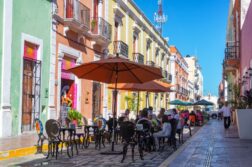…Calakmul is one of the great destinations to visit in Mexico.
…Declared a Biosphere Reserve and UNESCO World Heritage Site, it is the second largest lung in America and the largest tropical reserve in Mexico.

Here you can freely explore what was one of the most important Mayan cities, hidden in the jungle, under the watchful eye of the monkeys sitting in the trees.
But you have to deserve this adventure: it is located 5 hours by car from the city of Campeche near the border with Guatemala. That’s why few tourists come.
Calakmul means «two adjacent mounds» in Mayan, referring to the two largest pyramids at the site: Structures I and II. But according to some hieroglyphs, the city would also have had other names such as Kan «serpent» or Ux te tuun «three stones.»
Here they have found the largest number of steles in the Mayan world. Thanks to the valuable information they contain, it has been possible to reconstruct the history of Calakmul and the type of society it was.

Along with Palenque in Chiapas and Tikal in Guatemala, it was one of the most important and influential cities in the Mayan world.
A brief summary of its history:
• Occupied since the year 550 BC, it had its peak from the year 250 to the year 900.
• Between the years 636 and 695, Calakmul managed to establish a very powerful sociopolitical network.
• Defeated by Tikal in Guatemala, Calakmul had to reorient itself politically. The new rulers established relations with other cities located further north, such as Río Bec.
• Between the years 1000 and 1500, it was primarily a pilgrimage site.
• Since 400 BC. Until the year 1000, numerous scribes, painters, potters, sculptors, master builders and other figures were received who contributed to creating important works (buildings, murals, friezes, gigantic masks), as well as numerous colored vessels (for the houses of the elite and the tombs of great people), jade jewelry and masks, shell and wood objects, etc. It is also the place where the largest number of funerary masks have been found.
What to see in Calakmul

It is estimated that there are about 6,500 structures in the Calakmul archaeological zone, but so far only 21 structures have been «cleaned.»
You have 3 possible routes to visit Calakmul: a short one (2h), a medium one (3h) and a long one (4-5h).
There is a map at the beginning of the route that indicates all the accessible structures with the different itineraries.

1. Chan Chi’ich
It is a small residential area where large families lived with members who did not necessarily share blood ties, but were part of the same lineage.
A drainage channel was found to evacuate the large amount of water that fell during the rainy season and prevent flooding.
2. Chii’k Naab
It is a complex of 68 structures with plazas and corridors. It is believed that it was a meeting place for various parties and celebrations.
3. Great Acropolis
As the two previous sites were much smaller, this was the first large complex I had seen in Calakmul: impressive!

It was a large residential area divided into two main spaces: one semi-public and another private, reserved for the elite.
• The semi-public area: about 10 buildings around two plazas separated by structure XII: the north plaza (with a ball court) and the south plaza. Original access to the Acropolis was through Structure XIV, so it was effectively public, but access was limited and highly controlled.
• The private area: the governor and the elite of Calakmul resided here. There are about 70 structures around 17 patios and squares.
In addition to being residential, the Great Acropolis area had administrative, political, social and ceremonial functions. Tombs of important people with funerary offerings have been found in some of the structures, such as Structure XV, where three tombs have been found.
4. Great Plaza and Structure II
The Gran Plaza is the central square of Calakmul. It is surrounded by several structures, such as the famous Structure II. In addition to being the largest pyramid in Calakmul, it is also the heart of the city.
At 50 meters high (it reached 60 in its time), it is one of the most important pyramids in the Mayan world.
This pyramid was the center of power in Calakmul and the tomb of some of its leaders. So far 9 burial chambers have been found.
You have to go up to admire the view, beyond the top of the trees. And if you look closely, you will see some points emerging from the vegetation: they are other pyramids. Among them, to your left, you will see the other great pyramid of Calakmul: Structure I.
5. Structure I
At 40 m high, Structure I is the second most important pyramid in Calakmul, after Structure II.
Fortunately, after having climbed Structure II, your knees are already used to it! But be careful because the stairs are quite uneven.
From the top you also get a magnificent view of the surrounding area. And more or less in front of you you will see Structure II emerging from the trees. It’s a magical moment, I still can’t believe it wasn’t a movie set!
6. Small Acropolis and Structure III
This is the last resort on site before departure, so take advantage of it.
It is true that after the enormous Structures I and II, the Small Acropolis may seem less impressive because they are not really restored buildings.
Structure III is located on the edge of the Small Acropolis. It is a palace in which one of the oldest lineages in the city lived. Two tombs have been found here, one of them with offerings (dishes, jade masks) and plaques with hieroglyphic writings, indicating that the deceased was an important ruler.
7. Wildlife
The Calakmul reserve has a rich fauna: 235 species of birds, 5 of the 6 Mexican cats, numerous reptiles and monkeys.
As for the archaeological site of Calakmul, I saw several monkeys playing from one branch to another and a couple of ocellated turkeys strolling around.
You can discover the Mayan site of Calakmul in complete freedom, climbing to the top of the pyramids and other structures, which is not the case with most other archaeological sites in Mexico!
It is an archaeological site that is little known, but of great importance. This is a great advantage at the moment because there are very few visitors, which makes the place even more magical.
It is true that you have to be quite fit to be able to climb the many steps (and be able to go down them).
The big question is: is the 5-hour one-way trip worth it (+ 5 hours back on the same day if you return to Campeche)? YES, without a doubt.
It is a unique experience that you must live during your trip to Mexico.
How to get to Calakmul
The entrance to the Calakmul reserve is 4 hours from Campeche, 2 hours and 15 minutes from Bacalar and 40 minutes from Xpujil.
Then you have to calculate 1 hour more to get to the entrance of the archaeological site (driving at 30 km/h).
By car



• From Campeche: take Highway 261 south to Escárcega, and then Highway 186 to Chetumal. At km 95 (Conhuas), take the intersection towards the south for about 60 km. Important: when you pass through Escárcega, take the opportunity to fill your tank because there is no gas station until Xpujil.
• From Bacalar: 2h15 via México 186 and Villahermosa – Chetumal/México 186
• There is free parking
By public transport
To get to Calakmul by public transport, you have to take two things into account: you will have to arrive in Xpuijl first, spend the night in Xpujil and the next day, take the transfer from
From Campeche: departures to Xpujil from the South Terminal at 08:00, 13:30, 22:00 with Autobuses Sur, ticket 307 pesos
Where to stay near Calakmul?
If you visit Calakmul from or on the way to Bacalar, it is best to sleep in Xpujil. My hotel recommendations in Xpujil:
• Coa de Collar: good economic option in Xpujil with simple, but clean and well-located rooms, close to restaurants and supermarkets. Miguel, the owner, is a tour guide, which is very helpful. from 37 euros per night
• Ecohabitat: a country house surrounded by vegetation, comfortable, very clean, with a very good welcome. In the morning they bring you breakfast on the veranda, or if you prefer they prepare it to go. Delicious breakfast included, from 64 euros per night
• Casa Kaan: comfortable cabins with air conditioning, terrace and kitchen, in the middle of nature. It is an ecological accommodation that runs on solar energy, has several fruit trees and the waste is used as fertilizer for the garden. Breakfast included from 90 euros
•
What to bring to Calakmul?
You will be warm, not only from the sun, but also from going up and down the structures.
So bring light clothing and good walking shoes. From June to August, mosquitoes are especially voracious, so bring mosquito repellent.
Important: there is nothing in Calakmul, so it is suggested to bring some snacks and most importantly, lots of water!
Visiting Calakmul: other practical information
Here you have all the information you need to visit Calakmul:
• Entrance fee 255 foreign pesos, 90 pesos for nationals
• Optional guide 400 pesos (maximum 4 people)
• Open from 8 a.m. to 5 p.m. every day




